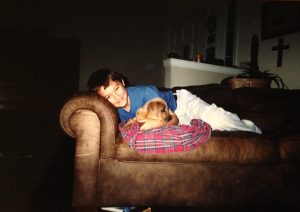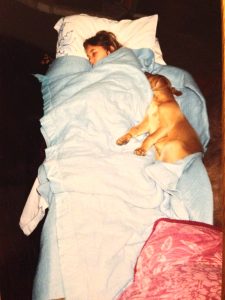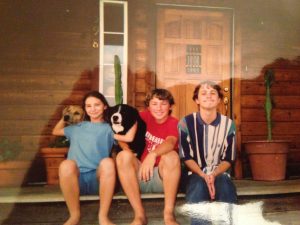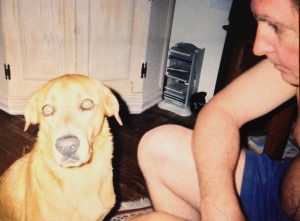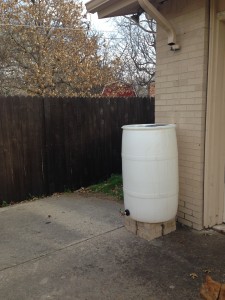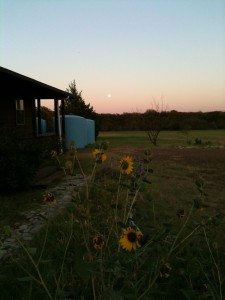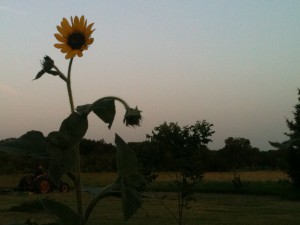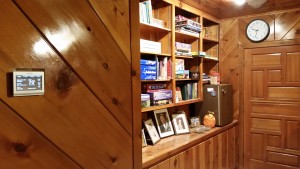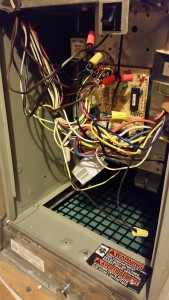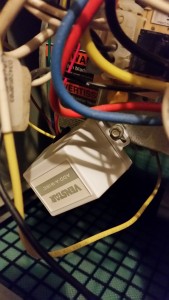Uncategorized
Then let me be brave in the attempt
“Let me win. But if I cannot win, let me be brave in the attempt.” — The Special Olympics Athlete’s Oath
Before the Really Big Weather hit Bryan, we were there for Special Olympics last weekend.
Sam has been competing in equestrian Special O since he was 12 years old. Yet, each year his instructors find new ways to challenge him. He’s become an independent rider, first in English style. This year, he’s riding Western, too. Sam practiced competing in a few “able-bodied” shows earlier this year to help him get ready.
All that preparation is no guarantee for gold. Some riders are more experienced and consistent. Other riders have horses that are competitors, too. For example, the first clip in the video below shows Sam in barrel-racing. This is his first year to compete in this event. He is working on smoothing out his turns and keeping momentum. That got him a silver this year. But the gold medal winner rode a horse that understands The Need For Speed. I’m not sure I could watch Sam on a horse that spirited. I watch and wonder how it tolerates having a rider on its back at all.
I didn’t include the clip from trail. Sam and his horse couldn’t finish the event. There was Big Weather (just not Really Big Weather) when we were there. The horses didn’t like it. And, there were rain delays. Sam had the option to ride trail either English or Western. He chose English. But not because he felt more experienced, but because of the horse. The team saddled up Magic for English and Revenue for Western. In the week leading up to the event, he and Revenue weren’t clicking. He was concerned. Although it’s not the best video to see the difference in his two equitation events, Revenue was the more consistent performer at Special O.
On the way home, Sam remarked, “I don’t know why I was worried about Revenue. He was great this weekend.”
And then he added, “At least I kept the oath. I was brave in the attempt.”
Our prayers to the people of Bryan, the Brazos River Valley and others affected by this spring’s severe weather and flooding.
True Blue Lacy
For the first time in 20 years, there are no dogs in my house.
Except for a very short, disastrous period with a hyper Corgi named Tippy, we didn’t have dogs when I was growing up. But I loved dogs. I studied all the different dog breeds. I read and re-read storybooks about dogs. I wanted dogs in my life.
Mark brought home our first puppy, Patch, when we moved to the farm in 1996. Part German shepherd and part chow, he grew to a gentle giant around the kids. A year or two later, a family we barely knew dumped their border collie mix at our place. We had tried once before, and failed horribly, with a rescue, so we worried about Rex. He had problems. But Mark had a good hand with dogs and slowly, but surely, Rex turned into a big, lovable lump.
As farm dogs, though, they weren’t particularly helpful. My dear friend, Terri, was having good luck with an old Texas breed, Blue Lacy, at her place in the Hill Country. She brought me her pick of the litter in January 2002.
He’d only been with us for a few weeks when Paige got the flu. He wouldn’t leave her side until she was up and about again.
Mark was a bit annoyed with me. Three dogs is a pack, he said, and they will be harder to manage. That’s ok, I told him, I want Gus to be my dog.
Gus entertained the kids as a puppy with his incredible energy. Once I sat my coffee down on the porch and he drank it as I looked away. The kids watched in wonder as he ran in circles, without stopping, for about three minutes, and then laid down and slept it off.
Mark saw that energy could — and needed to be — directed. In very little time, Gus became Mark’s dog. I did a lot of work on the farm, but Mark did more. Gus loved to work. All you had to say was “should we go do some work?” and he ran to the door with such excitement, bounding ahead of you outside. It really was his favorite time of day. With “go ahead,” he’d scout for you as you worked the fences or a row of trees, alerting you to snakes and chasing off varmints. With “get ’em up,” he rounded up the chickens and the goats when they got loose. He tried to help when other people’s livestock got on our land.
This photo is a classic shot of Mark having one of his sit-downs with a young Gus. I’m sure all that Gus heard was “blah, blah, blah” (I can’t remember what he had done wrong at this moment either), but more than anything, Gus wanted to please Mark. These little sit-downs were amazing bonding sessions.
So when Mark went to the store one night and never came home, Gus was as distraught as the rest of us. Twice he went looking for him and came home shot. Both times the veterinarian, Nub Nabors, shook his head as he looked at the x-rays. The first time Gus was shot, the bullet went clean through his chest and hit no internal organs of any kind. The second time the bullet went through the two bones of his front right leg as if threading a needle. Nub just stared at the x-ray in wonderment.
After that, Gus gave up looking for Mark.
Fast forward to life in the city, which I’ve written about before. He enjoyed these past 12 months of retirement.
Today was his last day. He got cancer and his haunches wasted away until he couldn’t hold himself up anymore. This morning, when it was time to get up and take our fake patrol in the ditch, his new favorite time of day, he gave up.
The humane thing doesn’t always feel humane.
Gus and I have been sleeping on the sofa together for nearly a year. I could sleep in my bed tonight.
But I won’t.
8 Mile: random thoughts running the hills at Possum Kingdom
When all your favorite trails for training have been washed out, or are under water, and you haven’t run a real trail race in a year, take an 8-mile romp to get your footing back. It’s not too short. It’s not too long. It’s just right. Drive two hours to run two hours and you will be with the other runners that look like runners. (It’s not your family’s Reindeer Romp. HT @PaigeCWolfe, first-time 8-mile trail racer). Chia seeds make a first-time trail racer hyper. When it rains in Texas, Texas turns green and purple and green and yellow and green and white, and green. A mockingbird perched on the safety light by the port-a-potties will sing all he knows, the chirps, the tweets and warbles, the chirrups and gurgles, the cardinal song, and the car alarm. What do you name your back country road when you can’t think of a name for your back country road? “Our Road.”
Catching
Sam has a certain smile that really sings.
He’s such a deep thinker that we don’t get to see this smile very much. Like the smile-for-the-camera smile most of us have, his face looks posed in photographs, only more so. But when a happy moment comes — like that moment when sunlight makes it through the clouds and trees all the way down to the ground to light a patch of wildflowers — Sam’s smile just sparkles.
He lit up that way yesterday when I showed him the rain barrel I brought home from a workshop. “We’re bringing the farm,” he said.
Well, almost. This is the barrel.
This was the farm’s.
We are growing vegetables in beds on the other side of the fence. That 50-gallon barrel should go a long way toward keeping things watered.
I’ll be writing about the rainwater catchment class and the barrel for Monday’s paper.
We have settled into the new place here in town pretty well. We enjoy the many and varied offerings that come with city life. We’ve all got bicycles and ride them around town more and more. But it’s not the same as life on the farm.
We made a very intentional choice to look around at what was missing and bring it in. The rain barrels, and living life closer to the rhythm of the seasons is part of that.
When you see blue-eyed grass covering our front lawn in the spring, you’ll know we finally got it as close as we could.
Sustainability
Earlier this fall, I was able to spend some time with a local biologist studying quail. I learned more in the course of that day than I was able to put in my newspaper story, which often happens.
The biologist has been working with area ranchers on ways to keep the prairie vital both for their cattle and the quail. On the drive back from Clay County, I saw all the ranches in new ways. Some looked like the ranch we had just visited, lush and vibrant. Others looked used up. I smiled to myself about our farm. When we sold it, our place looked like the former, not the latter.
The biologist started telling me a story about how he’d approached one rancher to bring his land into the quail “corridor.” The rancher agreed, but on one condition: it couldn’t cost him any money.
I could tell the biologist planned on telling me this story a certain way. After all, he was trying to build a big research program and do this good thing for the environment. He needed money for his labs and the students helping with the research. They were bringing new and important scientific knowledge where it was badly needed. The reality likely was this: a rancher that needs to make a change after doing things a certain way for years and years probably needs to spend a little money to get it back right.
Before the biologist got to the big finish in his story about the rancher, I blurted out, “so, really, he asked that whatever you proposed for his ranch be truly sustainable. Because for the changes to last, they can’t keep costing him money, right?”
(This is why people don’t invite me to dinner parties. I’m impertinent. I ask questions that stop the conversation.)
The biologist finished his story, telling me that it took awhile to make the changes to help the quail and figure out the true costs, but ultimately, the rancher didn’t lose any money running his cattle that year. The biologist had delighted in the discovery. But, I could tell by the many long and thoughtful pauses that came after I asked my question that he hadn’t thought about the sustainability of his quail program that way.
We didn’t farm our place with some lofty, progressive, green ideal of it being “sustainable.” We just knew we didn’t have any money and that anything we did needed to be harnessing and directing the little energy we, or the land, already had.
When we tried to help Sam learn to talk and become the marvelous person he was to become, we tried not to focus on hoarding resources. We just tried to harness and better direct the energy we, and he, already had. It worked pretty well.
Sustainability. Its a powerful word. We are starting to use it a lot. I’m not going to let it lose its meaning for me.
WinterFest 2015
It’s been some time since I posted video of Sam riding horse. They had a friendly show at the barn today, just the kids who ride with Born 2 Be in Aubrey. It looked like a good way to get all the willies out before they head to Chisholm Challenge at the Fort Worth Stock Show and Rodeo next month.
After they were all done with their competition, they rode to Christmas music and played a few games on horseback that was a lot of fun to watch. Then, the gracious owners of the facility, Valhalla Stables, rolled out a taco dinner and s’mores over a fire pit in the arena. Best way ever to have an end-of-year party for everyone.
Here’s equitation ride (watch for how Rosalie, the horse, shows the trainers she’s had about enough of the bridle they have on her):
Here’s the trail (watch for the canter over all four poles, and the patient determination at the gate):
And here’s that most excellent fire:
Smart thermostats anywhere
By Sam Wolfe, Guest Blogger
According to the recently published news story, “Smart thermostats remember for you,” a thermostat that is “just about as smart but doesn’t connect to the Internet” was installed in the back side of this home. (We live in northwestern Denton.)
Only one wire was available to power the thermostat. According to HVAC technician Bill Clark, the thermostat pictured in this story needs two wires to operate, a hot wire and a common wire, as do all other smart thermostats you can buy.
Research shows that the common wire is not available in some applications with a non-heat pump system. This requires battery power to a digital thermostat. Only a conventional thermostat or a programmable thermostat (one that is “just about as smart but doesn’t connect to the Internet”) could be used in these applications … until now.
With a Venstar Add-a-Wire accessory box and diode, you can simply “turn one wire into two.” For more information about this accessory, follow this link:
Note from Peggy: Sam was terribly disappointed after we were able to install an internet-ready thermostat in my house, but not his apartment. (For want of that wire. I wasn’t going to pay to lay more wire in the attic.) He went in search of a solution to that problem and found the add-a-wire device. After I asked him to make sure it was UL-listed, he ordered it, and then installed both the add-a-wire and the internet-ready thermostat in his apartment (which is in the back of the house) himself. He took the photos of his handiwork so you can see what he did.
What survives
Even before airlines got in the business of charging for your luggage, I packed as little as possible. I spent a week in the Florida Keys with my sisters living out of a small suitcase. My inappropriate dress for an impromptu dinner at a swanky tapas restaurant in Key West notwithstanding (hey, it was ok for Sloppy Joe’s bar, plus it was pouring rain most of the day), I believe I still packed too much.
The last time Mark and I spent a week in Hawaii, we took one large suitcase between us. The only time I flew with more than I could carry was on the way home from Japan. I spent the fall of 1986 there as a music student and visiting artist. I flew over with one euphonium and came home with two. I brought back reams of sheet music, both original compositions and inventive arrangements. I managed to keep everything confined to a trunk and carry-ons. When I got off the plane, I rented a cart and yet could barely balance all the luggage as I wheeled through Honolulu International Airport.
Over the years, little of what I brought back remains. I’d always suffered from TMJ, but it became untenable 15 years ago and my horns went in the case for good. After Mark died, I sold them and donated all our music, including what I brought back from Japan, to our alma mater.
I hung on to a few small things over the years that I treasure from that time, including a set of eight Japanese prints that I was finally able to get framed earlier this year.
During my time as a student at Kunitachi College of Music, I took a history of Japanese music class taught by a brilliant historian who, unfortunately for me, didn’t speak much English. (My Japanese was terrible.) Another student attended class with me to translate. Hiromi did her best to explain. The professor was kind and gracious. At the end of the fall term, he invited Hiromi and me to his home for lunch and tea. He wanted us to see his traditional garden and his collection of wood block prints, which Hiromi told me was famous. He seemed to have tended to every branch and blade of grass in his tiny garden. He filled one room of his home from floor to ceiling with boxes of traditional wood block prints. It was like being in the back room of a great museum with the collection’s curator. He wanted me to have one set as a gift. I was stunned. When I picked a brightly colored set that wasn’t very valuable, he told Hiromi to tell me that I really could have any one I wanted, even a valuable set. I demurred. I think Hiromi helped us both save face by reminding him that Americans have odd taste.
He put the set in a little manila envelope. That envelope managed to move from Japan to Colorado, and then to California, and finally to Texas intact. I was lucky. In 1996, Mark and I met a lovely couple through church. When Mark learned that Marcy was a conservator, he showed her the Wolfe family Bible and asked for her advice on how to best keep it and some of the items that had been tucked between its pages, including a braided lock of blond hair.
Somehow my little collection of prints fell out in that show-and-tell. Marcy saw them and said they needed to get out of the manila envelope. She helped me put them in acrylic sleeves. They sat in the conservation box with the family Bible for another 20 years.
After I sold the farm, it was time to get them framed. Museum glass and everything. I had so little left from Japan, I wanted to enjoy these prints.
When I dropped into Art Alley and pulled the prints out of the acrylic sleeves, I watched owner Randy Axtell’s eyes pop as he took a step back. “Oh wow. These are the real deal,” he said. He measured and measured again. We made a careful plan for framing.
Randy urged me to write the story of how I came to own the prints and put it on the back of the frame for posterity.
This is the start of that story.
I still don’t know a thing about them. I would imagine some expert would tell me they are all hung in the wrong order or something.
That’s not what’s important to me. I love the bright colors and the scenes they depict.
These eight pieces of paper have endured.
That’s a story right there.
What we do for air conditioning
I doubt my late husband could have convinced me to move from California back to Texas without the miracle of air conditioning. I still marvel at how I lasted the first months of my freshman year at North Texas State University, moving from central Wisconsin into an un-air conditioned room on the fourth floor of Bruce Hall.
(There were showers full-on cold every morning and night, swimming in the pool that used to be across from Willis Library, and everything iced. And more showers. Go, Mean Green.)
I try not to think about those beautiful California delta breezes at 4 o’clock in the afternoon in August in Texas. In Sacramento, the winds shifted just as the summer afternoon got hot. Those delta breezes pulled in air cooled by the Pacific Ocean.
Summer outstays its welcome here in Texas, the way winter does in Wisconsin. Air conditioning makes it bearable.
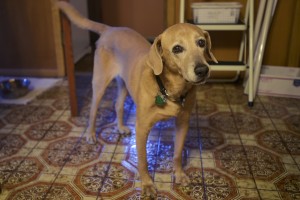
So does splaying out on the kitchen floor tile, as my dog, Gus, would tell you if he could. Photo by David Minton
Gus doesn’t like the air conditioner in our new house one bit. On move-in day April 1 and for a day or so after, he wouldn’t go down the hall towards any of the bedrooms. I didn’t figure out why, and it passed. Only later did I understand that it passed because I turned off the air conditioner until June.
We had an unusually cool, wet spring. I wanted the peace and quiet. My house was built in 1961. Air conditioning for this house, like many homes of this era, came later. That means the system equipment that would be in the attic of a newer home was installed in our hall closet.
It’s loud.
Really loud.
After I turned the air conditioner on for the summer, Gus preferred to stay in the living and kitchen areas. When pressed, he would come into the first bedroom, which is my office, and hid under the desk while I worked.
Gus is an old guy. Come November, he’ll be 14, which makes him about 78 in dog years. After we sold the farm and moved to town, it was fun to watch him recognize that his patrol duties had shrunk to a city lot down from 10 acres (with the additional security risk of a creek running through part of it).
You could almost see it in his eyes. “Hey! This is great! I can retire!”
We have a new routine that includes lots of fake patrols through the drainage ditch behind the house. Instead of napping under the porch, he naps in the garage.
At night, he’d whimper and cry when I headed for bed, which soon became crying whenever I went down the hall. Still, it took me a few days to figure out it was the air conditioner that was bothering him. At first, to help him out, I carried him down the hall, past the unit, at bedtime. But then, he started getting anxious as I would get ready for bed. Clearly, he didn’t even want to be carried down the hall. I looked again and saw that there are intake vents both in the hall and in the master bedroom.
I gave up.
I set up the laptop in the kitchen. I hardly use the big Mac the way I used to for writing and research. I moved the sewing machine to the dining room. And every night since June, I throw the big decorator pillows on the floor for Gus, and I sleep on the sofa.
When Sam went to kindergarten at Argyle Elementary School, he was terrified of the school bells. The teachers worked it out that Sam would always be outside for a fire drill before the alarm went off. But the 9 a.m. attendance bell was becoming a problem. The kindergarten teacher told Principal Gaye Pittman that Sam would watch the clock earlier and earlier each day. He was developing an increasingly elaborate routine to try and anticipate the moment the bell would sound.
Gaye knew just what to do. She turned the bells off. Teachers would just have to remember to take attendance at 9 o’clock without a bell.
It’s August, Gus. It’s Texas.
We’re not turning it off.
How long can this go on? (Or, where’s my hockey stick?)
FIVE COMFORTING AUTISM LIES – A SUMMARY
1. There is no autism epidemic.
2. Autism is genetic and has always been with us.
3. Autism is nothing to worry about. It is just another way of being.
4. The belief that vaccines cause autism has been thoroughly debunked.
5. Those who claim to know otherwise are frauds or nutjobs. Best to ignore them.
These lies, when repeated by those who believe them, are symptoms of ignorance, shock, and denial in the face of a medical catastrophe. At the current rate of increase, the annual cost of caring for Americans with autism spectrum disorder — including health services, residential care, special education, transportation, and employment support — could reach $500 billion or more by 2025 (Paul Leigh, Ph.D. Center for Healthcare Policy and Research at UC Davis). Struggling families need help now. Since Representative Posey’s June 29th revelations on corruption and coverup on the CDC, ignorance is no excuse. How long can this go on?
Although there is an oblique suggestion that vaccines cause autism (I’m not convinced there is any good science to support that claim), the rest of the information underscores an important point. The burden that comes from this alarming rise in the incidence rate is not sustainable.
My youngest sister left physical therapy to earn her master’s degree in health administration. Now, she’s one of those people who try to help health care improve, and be accountable, by watching the science and the outcomes data. She said when a graph looks like a hockey stick, there’s real trouble: 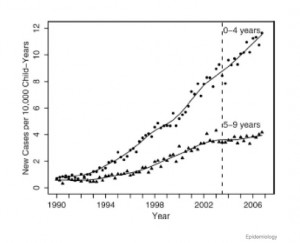 (Citation here)
(Citation here)
I don’t have an MHA. But I played field hockey in school. I’d call that a hockey stick.
I have tried to explain this alarming rise in conversations with friends and colleagues. They seem to understand, but I can tell it doesn’t sink in.
One time I think I got close. I told people that when Sam was born, the cost to care for him would be borne by more than 10,000 people because he was one in 10,000 or more. Today, it seems 1 in 66 babies will have autism. That means the burden 10,000 used to bear now goes to just 66 of us.
It isn’t just a communication problem. We are bombarded with so much information every day. People throw around big numbers in science stories all the time. We feel small. And powerless. We send money to Comedy Central’s Night of Too Many Stars and hope that helps.
It’s just not acceptable. Something horrible is happening and we have to make it stop.
I think I’m going to start carrying around a hockey stick.
